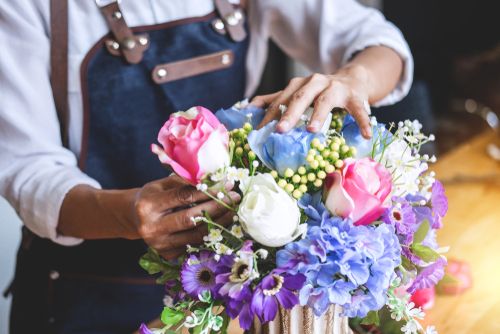 Maybe you’ve meticulously crafted your wedding from start to finish. Or you’ve taken a more laidback approach to your main event. Either way, postponing your big day is never an easy decision. And when you reschedule, you’re dealing with lots of minor details. The same flowers you picked for a spring ceremony may not be available in the fall. No one plans their nuptials expecting to change their date, venue, or other major elements. But you can take some steps to have beautiful wedding flowers at any time of year.
Maybe you’ve meticulously crafted your wedding from start to finish. Or you’ve taken a more laidback approach to your main event. Either way, postponing your big day is never an easy decision. And when you reschedule, you’re dealing with lots of minor details. The same flowers you picked for a spring ceremony may not be available in the fall. No one plans their nuptials expecting to change their date, venue, or other major elements. But you can take some steps to have beautiful wedding flowers at any time of year.
Be Flexible About Your New Date
When moving your wedding date, everyone should be on board – including your florist. First, you should talk to your pro about choosing a new date. Wedding planner Cindy Savage stresses the importance of flexibility in making new arrangements. You may need to pick a weekday or daytime slot if you want to keep the same vendor. You should also be prepared to pay a little extra: Your florist may have already spent money on ordering flowers for your original date.
While you’re at it, you should review your florist’s contract. The Knot explains that vendor contracts typically contain clauses about contingency plans and alternative solutions. They’ll usually spell out cancellation policies, but you should look for specific language that addresses rescheduling.
Choose Year-Round Varieties
Many popular flowers are available during the entire year. Samantha Iacia mentions several in a Wedding Wire piece. You’ll probably notice tried-and-true favorites such as calla lilies, roses, gardenias, and orchids. Some uncommon options include freesia and lisianthus. Also called “prairie gentian,” lisianthus is a rose-like flower that grows in warmer climates and comes in several pastel shades. Some year-round varieties fall into the “big blooms” category. Used sparingly, they add drama to your arrangements.
Be Open to Seasonal Substitutions
Using seasonal flowers can keep your costs lower. The only downside is availability: If you’re forced to reschedule, your favorites may not be available. And even if your florist can get them, they may not work well for your new date. Poinsettias chosen for a December wedding can look out of place at a July ceremony.
While swapping out your original selections, you should keep a few things in mind. You’ll probably want the same color scheme, so this gives you some flexibility. Look for alternatives with the same color and size. You could trade those poinsettias for large red summer varieties such as dahlias, poppies, or hibiscus blooms. Large roses are even better since they’re multi-seasonal. If you’re struggling with picking new flowers, consider leaning on your florist for assistance.
Keep It Simple and Stunning
Time is of the essence when you’re rescheduling your wedding. With that in mind, you may want to pick simpler arrangements that take less time to craft. Not only are they easier and faster for your florist to make, but they can also shave a few dollars off your final bill. Sticking with two types of flowers will also simplify things, as The Knot’s Lauren Kay reveals. This also streamlines the ordering process and makes assembly a little less complicated.
Wedding planning can be stressful by itself. Toss in the complexities of rescheduling and you may wind up with a logistical mess – or not, if you follow some smart advice. When working with your florist, you’ll want to stay flexible with your new date. If you must choose different flowers, keep an open mind. Focus on overall visuals such as color and size instead of sticking with specific details. All-season flowers can make the process easier. Finally, opting for simple arrangements can save you and your florist some headaches. With these tips, you’ll still get gorgeous flowers on your big day.